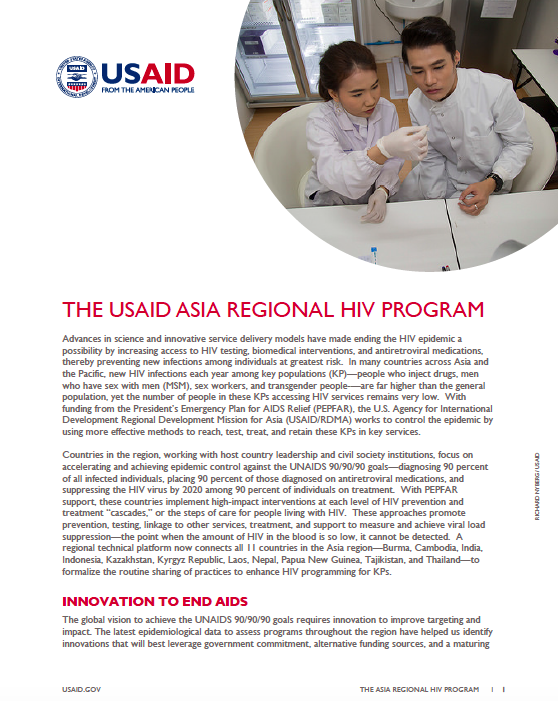Speeches Shim
The USAID Asia Regional HIV Program ![]() (pdf - 286k)
(pdf - 286k)
Advances in science and innovative service delivery models have made ending the HIV epidemic a possibility by increasing access to HIV testing, biomedical interventions, and antiretroviral medications, thereby preventing new infections among individuals at greatest risk. In many countries across Asia and the Pacific, new HIV infections each year among key populations (KP)—people who inject drugs, men who have sex with men (MSM), sex workers, and transgender people-—are far higher than the general population, yet the number of people in these KPs accessing HIV services remains very low. With funding from the President’s Emergency Plan for AIDS Relief (PEPFAR), the U.S. Agency for International Development Regional Development Mission for Asia (USAID/RDMA) works to control the epidemic by using more effective methods to reach, test, treat, and retain these KPs in key services.
Countries in the region, working with host country leadership and civil society institutions, focus on accelerating and achieving epidemic control against the UNAIDS 90/90/90 goals—diagnosing 90 percent of all infected individuals, placing 90 percent of those diagnosed on antiretroviral medications, and suppressing the HIV virus by 2020 among 90 percent of individuals on treatment. With PEPFAR support, these countries implement high-impact interventions at each level of HIV prevention and treatment “cascades,” or the steps of care for people living with HIV. These approaches promote prevention, testing, linkage to other services, treatment, and support to measure and achieve viral load suppression—the point when the amount of HIV in the blood is so low, it cannot be detected. A regional technical platform now connects all 11 countries in the Asia region—Burma, Cambodia, India, Indonesia, Kazakhstan, Kyrgyz Republic, Laos, Nepal, Papua New Guinea, Tajikistan, and Thailand—to formalize the routine sharing of practices to enhance HIV programming for KPs.
INNOVATION TO END AIDS
The global vision to achieve the UNAIDS 90/90/90 goals requires innovation to improve targeting and impact. The latest epidemiological data to assess programs throughout the region have helped us identify innovations that will best leverage government commitment, alternative funding sources, and a maturing regional civil society response to establish comprehensive and sustainable approaches. Through partnerships with national HIV programs and dynamic KP peer groups, we promote strategies such as targeted self-testing to identify more HIV-positive clients. PEPFAR is promoting client-centered approaches of care to simplify and adapt HIV services to reflect the needs and preferences of the various groups of people living with HIV, as well as new strategies to identify HIV-infected KPs across community and facility sites, promoting longer medication refills, access to leading HIV treatments in one-dose combinations, and integration of tuberculosis preventive treatment. In addition, the region is focusing on recency (determining how old the HIV infection is) and index testing (testing the client and his/her networks) for new diagnoses, particularly for people living with HIV, transgender people, and MSM.
EVIDENCE TO GUIDE ACTION
To scale up innovative service solutions, the regional HIV program helps strengthen policy and health systems and provide training for evidence-based KP programming and monitoring at all levels. Countries in the region will use unique identifier codes both in facilities and through peer navigators to track testing, antiretroviral treatment (ART), and viral load monitoring and suppression. In Thailand, these unique identifier codes and associated data are managed in eCascade, a system supported by PEPFAR, which allows the local organizations that serve clients to monitor achievement of their goals. Programs are evaluating and assessing, among other approaches, the impact of different community service approaches on performance across the treatment cascade, community-facility outreach models, nurse-led case management approaches and viral load suppression, and HIV service costing and transition readiness.
LOCAL CAPACITY FOR SUSTAINED ACHIEVEMENT
The regional HIV program works to enhance national HIV responses through common strategies for epidemic control, civil society engagement in policy advocacy, capacity building of local partners, and supporting collaboration among local and international stakeholders to generate more effective policies and programs. In Thailand, local partners advance the leadership and sustainability of community-based organizations providing quality HIV services to those most in need, accelerating desired health outcomes with a “Princess PrEP” model that is nationally and globally recognized as having contributed to more than 50 percent of all new PrEP users—more than 3,000 people—since early 2016.
PEPFAR PROGRAM REGIONALIZATION
In 2019, PEPFAR embarked on a major programming shift in Asia. Combining several operating units into one for the region, PEPFAR will increase efficiency, consolidate expertise and technical assistance, and advance and sustain epidemic control, with special attention to KPs and drivers of the epidemic. U.S. government agencies will maintain programmatic leadership within countries, while overall PEPFAR regional coordination will occur through an Asia Region PEPFAR Coordination Unit in Bangkok. All 11 countries in Asia under this regional platform continue to prioritize PrEP, index and self-testing, gender-affirming service delivery, flexible service delivery models, and same-day ART, reducing stigma and discrimination, providing unique identifier codes to support retention in services, and improving data use. All countries have the goal of full access to viral load testing, and plan to support policies and practices that lead to multi-month treatment prescriptions and expanded access to once-a-day, fixed-dose combination antiretrovirals.


Comment
Make a general inquiry or suggest an improvement.